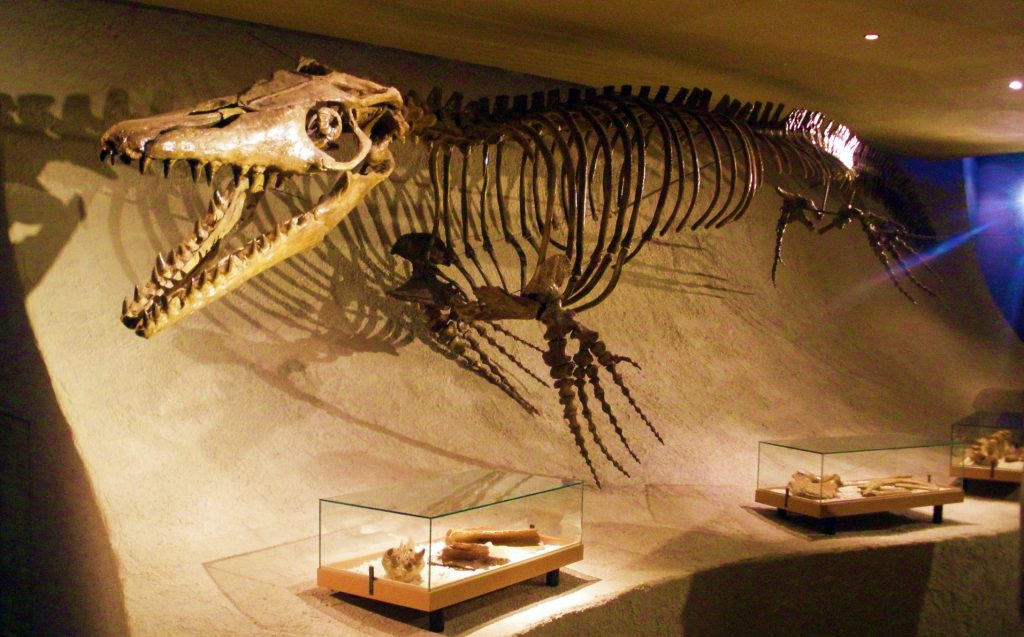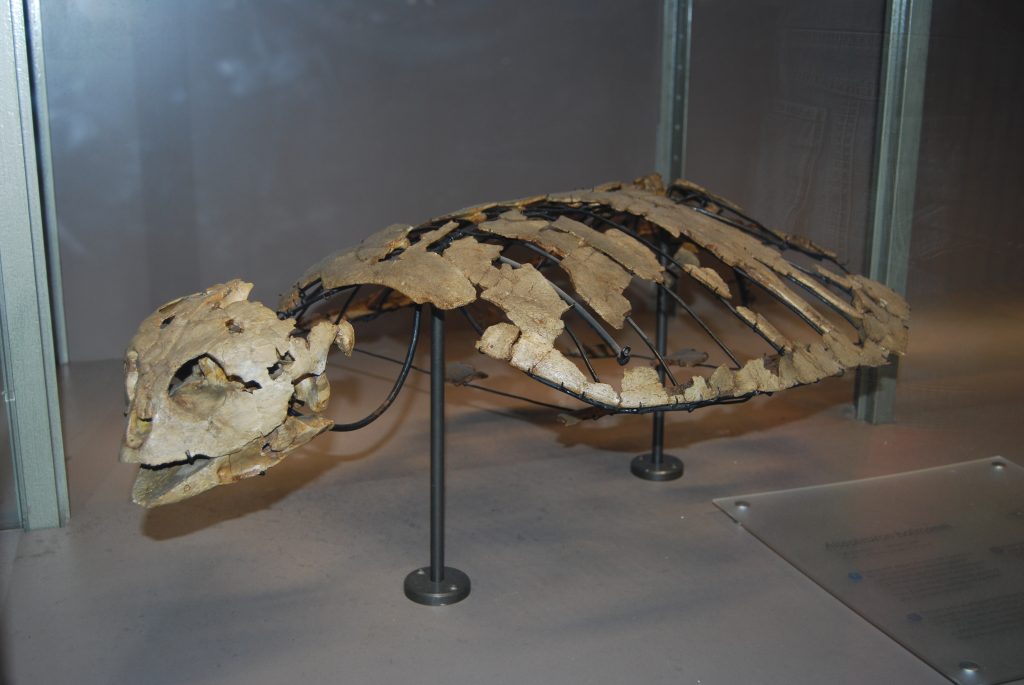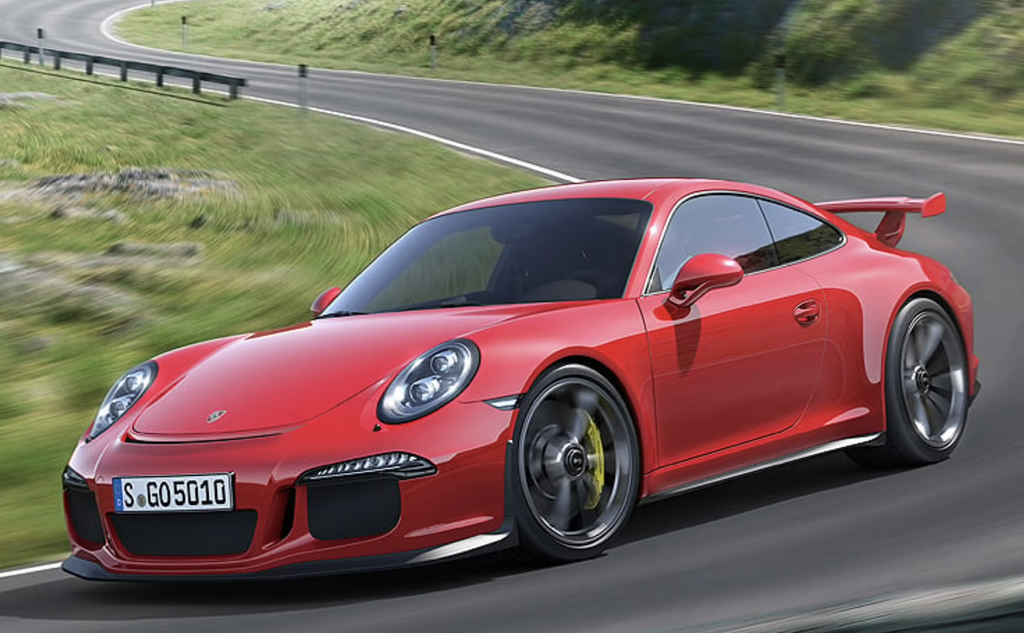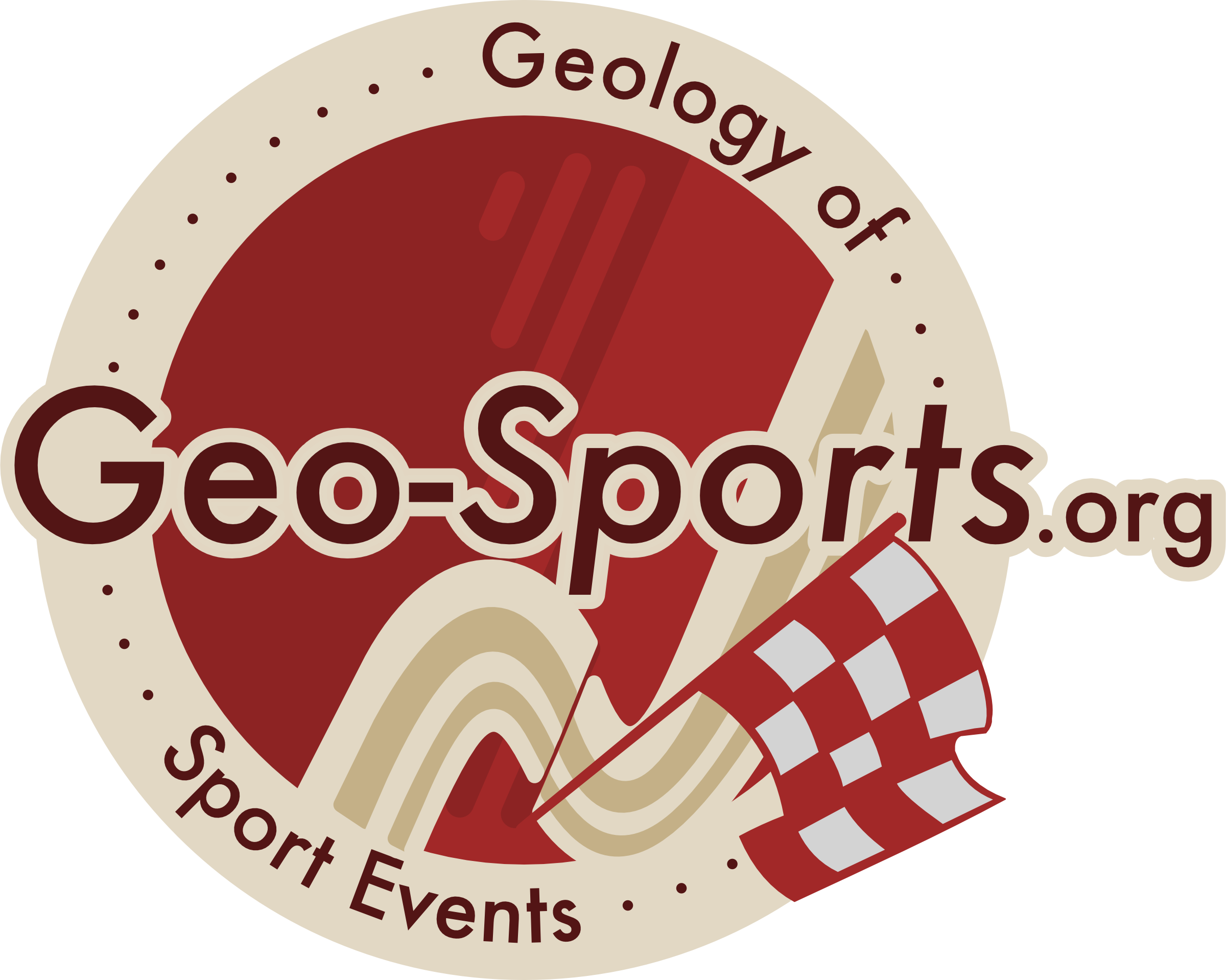On stage 4 the peloton races through the province of Limburg. We meet a local dinosaur, eh sorry lizard, there and find out how fast could it swim. Could it chase its prey at Porsche speed? Or was it just a bit too heavy for such high speed chases. Let’s look into the chase of the mosasaur.
Large parts of the subsoil of the Limburg hills consist of limestone, as we explained in the Amstel Gold Race blog. It is a limestone called (geologically totally incorrectly) ‘marl’. We know by now that where we find limestone there was a sea. It covered large parts of the Netherlands at the end of the Cretaceous, so at the end of the dinosaur age. Remains of mosasaurs are occasionally found in the limestone as our Amstel Gold Race video shows. Let’s meet our local one: the mosasaur names after the Meuse river.

Although they lived in the dinosaur age, and the name ends in -saurus, mosasaurs had nothing to do with dinosaurs. Snakes, lizards and mosasaurs share a common ancestor. This puts mosaurs, along with lizards and snakes, in a very different group of reptiles from dinosaurs. For the dinosaurs, and their descendants, the birds, a very different, entirely separate branch in the reptile family tree is reserved. So, we cleared that up.
A succesful predator
The story of mosasaurs began some 100 million years ago, when their lizard-like ancestors took the step back into the water. In just over 30 million years, they evolved into a particularly successful group of marine reptiles. Their fossils are found all over the world. The largest specimens grew more than 15 meters long. The various species had taken over numerous different niches in the seas by the end of the Cretaceous. Large carnivores swam around, some with morphing teeth of Tyrannosaurus rex proportions, into which a sea turtle could easily disappear. Other species, on the contrary, had pointed teeth to catch small fish, or knobbly teeth to crack oysters. At the end of the dinosaur era, mosasaurs also died out in the sea, just like the dinosaurs on land.

Paddle harder
But how did mosasaurs scavenge for food? For some prey, you don’t need to be able to swim fast. Catching oysters is not a pursuit sport, and a sluggish sea turtle probably wasn’t too big a challenge for a hungry Prognathodon either. To outsmart faster and more agile prey, mosasaurs also had to pedal eh paddle briskly. To be more precise though, use its tail. The propulsion of these marine reptiles came mainly from the muscular tail. The paddles, the flippers, those had mainly a role in steering.
Was the mosasaur hunting faster prey a chaser? An endurance athlete? Or were the hunting tactics in those species more something of short peaks like a sprinter? Was such a mosasaur lurking, among the seagrass, to pop out in a flash if needed? Were some mosasaurs perhaps ‘ambush predators’?
Feed zone
There has been much speculation about the eating habits and hunting tactics of the various mosasaurs. Recent research is starting to give us a better picture of their eating habits. At Utrecht University, palaeontologist Femke Holwerda has recently taken an extensive look at the wear marks left on the various mosasaurs’ teeth from the Maastricht limestone. Not surprisingly, we see considerable damage on the tooth enamel of a mosasaur that we already suspected cracked shells. And not surprisingly, the tooth enamel of a mosasaur with sharp incisors, very suitable for slicing softer meat, looks a lot less damaged.

Very occasionally, we also find mosasaurs with stomach contents. From Canada, we know of a Prognathodon fossil with a piece of half-digested sea turtle in its stomach. And from Angola, we recently published a mosasaur with no less than three hunks of half-digested smaller mosasaurs in its stomach – one of which even turned out to be a congener, an indication of cannibalism.
Porsche speed
That Prognathodon probably didn’t have to swim very hard for that bite of sea turtle. The chase was not on, so to say. Possibly the mosasaur cannibal was a scavenger. However, maybe Mosasaurus hoffmanni, the large mosasaur with sharp teeth from the Maastricht Cretaceous Sea, was indeed an ambush predator? In a recent documentary released on Apple TV, Prehistoric Planet, there was much speculation about the talents of such a mosasaur as an ambush predator. A good ambush predator must be able to accelerate really fast. That’s not so easy when you’re very big. But surprisingly, in the documentary, the mosasaur was awarded very ambitious sporting achievements.

For instance, the acceleration of a 15-meter mosasaur -underwater, mind you!- would dwarf the acceleration of a fast Porsche. Either way, it makes for spectacular footage. A video of an animal no one has ever seen accelerating very fast with a powerful flick of its tail. But does it make sense? After all, Porsche-like acceleration under water when you are 15 meters long and weigh a few tonnes is quite something. The first law of biomechanics is ‘big things don’t move fast’. What do you need to proof the wild claims from Prehistoric Planet? Let’s analyze the chase.
The chase
For their physics profile paper, high school students David van der Mark and Wietse ten Hoor set to work with insights into the energy management of reptiles. They looked at the shape and dimensions of the tail. How fast was the chase speed? Below the line, these are not very different sums from what movement scientists and sports physiologists can make about the peak performance of cyclists. A certain amount of muscle tissue can briefly peak at a certain power output to chase an attack or sprint to the line. So a mosasaur cannot accelerate in one second more than what the muscles can deliver in peak power. That sounds obvious but with that David and Wietse managed to raise a few critical questions about the claims of the documentary makers.

How fast does a cyclist climb the Cauberg? How much spaghetti does it take to make it through a Tour de France stage? And how fast can you accelerate a tail with 1,000 kilos of muscle tissue underwater? These are all sums about energy management. No matter how much David and Wietse puzzled, the mosasaur certainly didn’t get out of place faster than the aforementioned fast sports car in their calculations under water.
Now if you were lurking among the sea grass 66 million years ago, you might not need to beat a Porsche at the stoplight sprint either – as long as you are faster than your prey, and perhaps invisible enough to surprise your prey only at the last moment. That’s all you need. Just be smart. Who will outsmart the competition in today’s chase?






